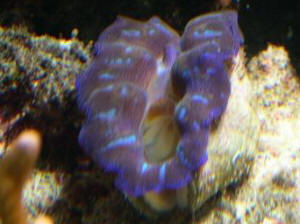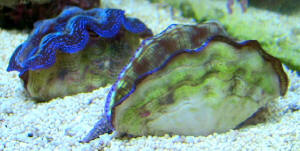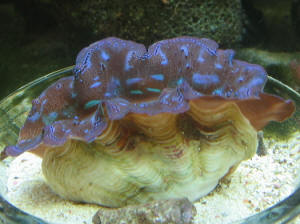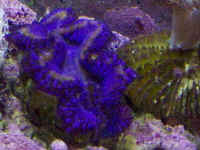|
FAQs about Identifying Giant Clams, family
Tridacnidae
Related Articles: Got
Tridacna? A beginner's guide to keeping Tridacnid
clams by Laurie Smith,
Example
Chapter from NMA Reef Invertebrates book, on Giant Clams,
Tridacnids, A Brief Guide to the
Selection and Placement of Tridacnid Clams by Barry Neigut,
Tridacnid Health:
Pinched Mantle Syndrome in Giant Clams by Dr. David Basti,
Deborah Bouchard & Barry Neigut, Bivalves, Mollusks, Lighting Marine
Invertebrates,
Related FAQs: Tridacnids 1, Tridacnids 2, Tridacnids 3, Tridacnids 4, Tridacnid Clam Business, Tridacnid Identification, Tridacnid Behavior, Tridacnid Selection, Tridacnid Compatibility, Tridacnid Systems, Tridacnid Lighting, Tridacnid Placement, Tridacnid Feeding, Tridacnid Disease, Tridacnid Reproduction, Bivalves, Bivalves 2, Lighting Marine
Invertebrates,
Kitty in a Clam
|

|
|
Clam ID 9/26/10
Hello WWM Crew,
<Hello Jason>
I recently acquired a clam which was outgrowing its' previous
home and I'm needing a bit of help identifying it. It is
rather large at fourteen inches from end to end and approx seven
or eight inches across when fully extended.
<Yowzah!>
It has tentacles around the in-current siphon which ruled out
gigas. It has some fairly prominent scutes but rather few, and
those that are there are quite widely spaced. The Maximas that
I've seen tend to have very closely spaced scutes and
Squamosa tend to have many large scutes. Any help in Identifying
this big guy would be greatly appreciated.
<Take a look at Tridacna derasa, I'm quite sure that is
what you have.>
Thanks in advance
<You're welcome. James (Salty Dog)>
Jason Rupinski
|

|
Re Clam ID 9/26/10 -
9/27/10
James,
<Jason>
Thanks for the quick reply. I had considered Derasa but the
one thing that threw me off was that this clam only has
four or five folds and they're fairly prominent. I have
a small Derasa and it has seven or eight folds and the are
not nearly as large as prominent as the folds on this clam.
I've attached another pic of the clam. I took this pic
when I was drip acclimating it and it hadn't opened up
yet.
<Based on my limited experience with clams, I felt your
clam was a derasa.
Since I do not have the time to do a study on Tridacna
identification for you, I suggest you do so by reading
James Fatherree's article on clam identification found
here.
http://www.reefkeeping.com/issues/2002-07/jf/feature/index.php
There are too many instances where querior's would like us
to do the footwork for them rather than Google for
themselves and find information that is readily available
on the web. Please read here re "Asking The Web Web
Media Crew a Question".
http://www.wetwebmedia.com/WWMAdminSubWebIndex/question_page.htm>
Thanks
<You're welcome. James (Salty Dog)>
Jason
|
 |
|
ARKive - your image of Tridacna tevoroa
5-7-09
Dear Robert,
<Eleanor>
I hope you do not mind me contacting you but in searching the internet
for images of tevoro clam (Tridacna tevoroa) I found a fantastic image
of yours on
http://www.arrecifevivo.com/v2/index.php?option=com_content&task=view&id=93&Itemid=49
which I would be interested in using for ARKive, if you would like to
become involved.
ARKive - www.arkive.org - is a unique conservation initiative.
<Ah, yes. A worthy effort. You are welcome (as are all
non-commercial concerns) to free use of any of my content; per here:
http://wetwebmedia.com/WWMUsePolicyStmt.htm
Thank you for your efforts. Bob Fenner>
Films, photographs and audio recordings of the world's animals,
plants and fungi are being gathered into one centralised digital
library. To date we have created digital multi-media profiles for
nearly 4,000 species, digitising and storing more than 25,000 still
images and over 60 hours of moving footage. These important
audio-visual records are being preserved and maintained for the benefit
of future generations and are being made available via the ARKive
website.
I have attached some documentation that will tell you a lot more about
the ARKive project. However, in summary:
· It is ARKive's current aim to compile audio-visual
records for the 17,000-plus species currently threatened with
extinction, according to the World Conservation Union's (IUCN) Red
List of Threatened Species.
· We are looking for media (moving footage, still images,
audio) to depict each species' life history as comprehensively as
possible. In order for us to achieve this aim we need help from as wide
a variety of donors as possible and would like to be able to add you to
our list of contributors.
· The ARKive website acts as a showcase for image
providers, displaying copyright and contact details with every image
and links to each media donor's own web activities.
See examples of species which have been ARKived at www.arkive.org.
Please let me know if you would like to contribute to ARKive or if you
have any queries.
I look forward to seeing your images.
Best wishes,
Eleanor Sans
"ARKive is a noble project, one of the most valuable in all of
biology and conservation practice. It has whatever support I am able to
give it."
Professor E. O. Wilson, Harvard University
"Over the past few decades a vast treasury of wildlife images has
been steadily accumulating, yet no one has known its full extent - or
its gaps - and no one has had a comprehensive way of gaining access to
it. ARKive will put that right. It will become an invaluable tool for
all concerned with the well-being of the natural world.'
Sir David Attenborough
--------------------------------------------------------------------
Eleanor Sans
ARKive Media Research Assistant
BBC E-mail: New giant clam species
discovered 8/30/08 <Thank you Neale.
BobF>> Neale Monks saw this story on the BBC News website and
thought you should see it. "The coral reefs in particular... may
still harbour very large surprises," said Dr Richter. ** New giant
clam species discovered ** Scientists have discovered the first new
living species of giant clam in the Red Sea in over two decades.
http://news.bbc.co.uk/go/em/fr/-/1/hi/sci/tech/7588857.stm
| Tridacnid care & placement 4/1/07 <Hi
Glen, Mich here.> I have recently purchased two Tridacnid clams
which I am very pleased with. So pleased that I forgot their names
and could use some help with the ID. Both are young clams, slightly
larger than 4" long. In the attached picture I have
tentatively identified T. derasa in the foreground and T. Crocea in
the background (thanks to the descriptions in The Reef Aquarium,
Vol 1). I am fairly sure about the ID of T. derasa due to the
white, plate-like, symmetric shell which lacks scutes, displays
very little ribbing and has a narrow byssus gland. The other, I
believe, is T. Crocea due to the overflowing blue mantle, wavy
edges and scutes prominent only on the upper shell margin. The rest
of the shell has well-defined ribbing. Additionally, the shell
edges are asymmetrical, with the hinge side being shorter than the
byssus gland side. The byssus gland is also very large, rounded,
and extends almost to the shell edge. A few of the eyespots also
appear to extend above the mantle surface as if they were little,
short tubes. I am less sure of this ID since it also comes very
close to that of T. maxima and most pictures of clams are of
beautiful mantles, not shell features. Line drawings are of very
little help to me. <These ID's are correct.> Right now
the clams are placed directly on a 6" DSB, the top 2"
being comprised of CaribSea Reef Base substrate, which my sleeper
goby loves to sift through in this little lagoon. I am concerned
that as he does his work, the Reef Base falls onto the open mantle
of the clam and may aggravate the clam. I have even seen the clam
quickly close it's shell in order to eject a few particles
which have fallen into its incurrent siphon. I'm sure that
these animals are designed to contend with this situation, but
should this be a concern? <I would move these clams.> Since
my light source is two 65W PC 10,000K daylights and two 65W dual
actinics (260W total), I am planning to move them up onto the
rockwork to get closer to the light. <I think this is wise.>
Currently they are 18" from the light source and 14"
under the surface of the water, which is mediocre lighting. Moving
them up on the rockwork would put them 5" - 7" closer,
which should be much better for their health, but worse for our
viewing pleasure. <May want to consider moving them even
higher.> My only concern with placing them on the rocks is how
to move them when they grow bigger. Do I rock them a bit and cut
the byssus strands close to the rock? <I would avoid doing this
if at all possible.> Can I damage the clam if I do this?
<Absolutely. Hopefully the clams have not attached to the bottom
of your tank. What I would do is lift these clams up off the
sandbed and place them either on a flat rock, a large reef plug or
in a clamshell and allow the byssal apparatus to attach. This will
make the clam portable and allow you to move the clam if the need
arises. Basically it provides options and I think options are good.
More here and links in blue at the bottom: http://www.wetwebmedia.com/ca/cav1i3/Clam_care/Clam_care.htm
-Glen |
|

|
Giant Clam Species Identification - 02/24/06 I
think I sent to wrong email address yesterday.... Nice website! I am
trying to identity a couple giant clam specimens so I can read about
their individual needs. Attached are photos of these specimens. Any
help you can provide in identifying them would be very helpful. You
will also notice that the brown clam's mantle is a bit washed out
(white) in the middle. At night the incurrent siphon is more round than
oval which is also concerning. I have been feeding it a combination of
DT's marine live phytoplankton and marine snow typically daily.
Lighting is 280 Watts T5 bulbs for 46G tank, both clams are within the
top 10" of the tank. Thanks Greg <<Greg, the pictures
won't open/are corrupted...do try sending again. Regards,
EricR>>
| Clam I.D. and care. 1/31/06 hey guys how is everything
going. <Great, thanks for asking.> Well i recently purchased
a small clam at my LFS and I know its super healthy it reacts to
the slightest shadow or movement. I have had it for a week now. The
problem is I don't know what type of clam it is. the guy at the
store told me he thought it was either a maxima or Crocea.
<Looks to be T. Crocea.> I have provided some pics so you can
help me out. He is currently sitting about 14" under a custom
sea life 130 watt fixture 65 of 10,000k and 65 of actinic. <Move
him as close to the top of the tank as possible with this lighting.
And remember to change your bulbs at least every 9 months.> I
also have moon lights and am feeding him DT's Phytoplankton 3
days a week. any suggestion. <Keep calcium high and water
quality stable.> please let me know thanks again. Ohh i almost
forgot its a 30 gallon tank. <Adam J.> |
|

|
Tridacnid ID - 01/28/06 Hello Wet Web Media Friends,
<<Hello Darryl>> Like many before I love (like very
much) your website... Thank you. <<Good to hear.>> I
have the opportunity to purchase a clam, I've been wanting one
for a couple years but have felt my tank wasn't ready, it is
now a thriving two years old. <<Cool!>> The clam in
question is the one in the attached pictures. I am told it is a
Tridacna Squamosa but from the research I have done I believe it is
a Tridacna Crocea clam, can you confirm my suspicion for me as this
will obviously have an effect as to the placement of the clam in my
tank (among other things). <<Hmm...the pics are a bit fuzzy,
but the absence of 'prominent' scutes (the scalloped
projections on the shell), and the color/pattern, lead me to think
you are correct.>> I am also concerned about the opening as
it seems quite large. It has great coloring and it responds well to
the fish swimming by, very responsive opening and closing.
<<It does look to be "gaping" a bit...but this may
simply be dir to handling/shipping stress. The responsiveness is a
good sign.>> I have a 180 gallon tank with 2x250watt 10,000k
metal halides, 2 96 watt 10,000k power compact fluorescents and a
96 watt actinic. The clam would be about 8" from the top of
the water and directly under a halide that is another 6-8"
from the top of the water. It would be sitting on the center of a
rock 'plate' that is about 12" in diameter. Would this
be a good place for him/her? <<Should be fine, though this is
really more light than it "requires" to survive. I have
two T. crocea sitting on the bottom of a 30" tank (6"
DSB/24" water column) under 250w 10K MH lighting. They have
been thriving and growing for more than 18 months now.>> I
have already used Wet Web Media and other sources to answer the
rest of my questions (assuming I'm correct in the
identification:) <<Excellent!>> Thank you for your
time, Darryl K. Edmonton, Alberta
<<Welcome, EricR...Columbia, SC>> |
|

|
| Coral question and clam identification?
Water quality in 55 gallon tank. PH 8.4 Ammonia 0 Nitrite 0 Nitrate
0 Calcium 340ppm Alkalinity 9.8 dKH Salinity 1.025 Temp 78 - 80
Lighting 1-Actinic 95w VHO 1- Aquasun 95w VHO 1-Actinic 30w
Coralife 1- 10,000k 30w Coralife <Okey-dokey> This piece of
coral is about 6 inches from the top of the tank and has looked
like this for a few days now. <lighting is somewhat weak for
this Neptheid (AKA "Kenyan Tree Coral"), but unlikely to
elicit this response> It was about 12 inches from the top a few
weeks ago and looked good when I moved it but now it looks like
this. <perhaps a just acclimating> Is this normal or is it to
close to the top of the tank? <definitely not too close... in
fact, this beautiful coral will turn turquoise under a bank of VHO
blues (2-4 lights)> Also can you please identify this type of
clam for me. It has a brownish look to it although it looks a
little different in the picture. Thank You. <I would need a
better picture to be sure but you may have a very interesting clam
here! Tridacnids are rather easy to identify but yours looks like
it could be a hybrid of two species known to hybridize. The mantle
is conspicuously like a T. squamosa... but the shell does not have
the characteristic worn scutes of a T. squamosa, and instead looks
worn and ribbed like a T. derasa. Still the picture is not clear
enough. A close up of the shell and mantle separately would help if
clear. Best regards, Anthony> |
|

|
Tridacnid clam Hi Bob, <Anthony Calfo in
your service> I have a really good relationship with my LFS.
<excellent! a blessing that not all aquarists enjoy> Due to
this I am able to order some unusual items, and can pick them up on
delivery from the suppliers, before they even enter their tanks.
For this reason I sometimes have to rely on them for quality, and
it works out to be beneficial 99% of the time. However about 3 1/2
months ago I asked for them to get some Tridacnid clams, and gave
my list of preference. When I arrived they had hand picked a blue
Maxima or derasa (my guess I was too excited to ask) for me still
in it's bag and difficult to visualize. <T. maxima it is>
When I got home it unfortunately had some brown areas along both
sides of the mantle (see picture enclosed). <not unfortunate...
perfectly natural and rather common pigmentation> I thought it
was just due to being under poor lights and it would recover.
<will not change my friend> I have had it for over thee
months in my 125g reef. It is within 2 feet of the lights which are
2-140 actinic VHO for 8 hrs/day and directly under one of three 175
cheapie 55K Venture MH for 4 hrs/day. I replaced the MH. about 6
weeks ago as it was slightly yellow, the new one is much whiter. Is
this just some normal marking or am I in for trouble. <relax and
enjoy this beauty... a nice specimen> The clam is always
extended and closes very fast when a fish swims too close. <very
good responses...healthy> Any ideas would be appreciated.
<Tridacnids are graded by color on export and few of the
"cover girl" blue seen in books and magazines make it to
the USA. Some Germans and many more Japanese aquarists are willing
to pay a much higher dollar for select ultra blue clams than
American aquarists. So... we do get some very nice clams... but
most/many have variable pigmentation. Your specimen is very nice
overall and likely a better deal at under $100 compared to the
$300-600 USD needed to get a hand picked (ultra grade) pure blue
specimen> Thanks Larry
<best regards, Anthony> |
 |
|
|

